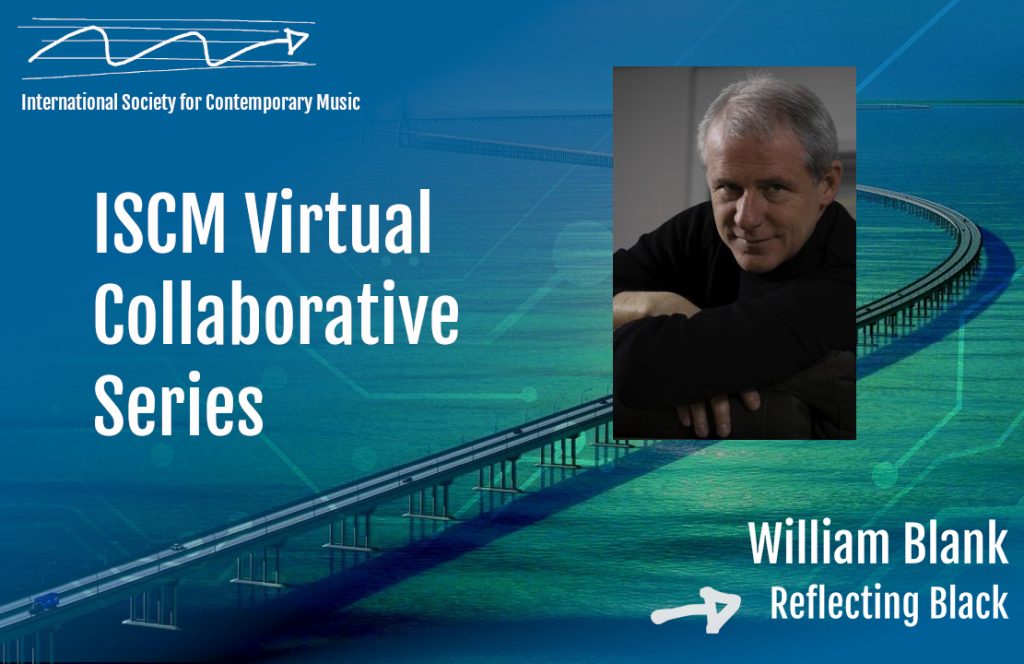William Blank: Reflecting Black

William Blank, born in Montreux in 1957, is active as both a composer and a conductor. He is currently responsible for contemporary music at the Music Academy HEMU in western Switzerland, where he directs the Ensemble Contemporain and teaches composition and analysis. Blank’s compositions are performed throughout Europe and in the USA and Japan, in prestigious concert halls such as the Victoria Hall in Geneva, the KKL in Lucerne, the Zurich Tonhalle, the Philharmonie in Paris, the Zaal Koningin Elisabeth in Antwerp, the Wigmore Hall in London, the Jacqueline du Pré Music Building in Oxford, the Leipzig Gewandhaus, the Vienna Musikverein, the Salzburg Festpielhaus, the Mariinsky New Concert Hall and the Philiharmonie of St Petersburg and the Suntory Hall in Tokyo. His music has been performed by conductors such as Armin Jordan, Antony Wit, Fabio Luisi, Pinchas Steinberg, Kasuyoshi Akiyama, Zsolt Nagy, Jean Deroyer, Dennis Russell Davies, Pascal Rophé and Heinz Holliger. He has collaborated in particular with the Kammerorchester Basel, Ensemble Intercontemporain, Ensemble Contrechamps, Collegium Novum Zürich, Ensemble Paul Klee as well as with numerous internationally renowned artists such as the Quatuor Sine Nomine, Amar Quartet, pianist David Lively, cellist Jan Vogler, trumpeter Alison Balsom, violist Geneviève Strosser, the singers Rosemary Hardy and Natalia Zagorinskaja, the MDR Orchestra Leipzig, the Tokyo Symphony Orchestra, the Orchestre de la Suisse Romande or the Swiss Chamber Soloists. In 2001, Blank was awarded the Prize of the Cantonal Bank of Canton Vaud for his life’s work hitherto. Then, as part of his residency with the Orchestre de la Suisse Romande, he wrote Exodes, dedicated to Kofi Annan, which was given its first performance in October 2003 on United Nations Day in New York. He also gave a masterclass about the work at the Juilliard School of Music. Blank’s works have been released on numerous CDs as recently his complete orchestral works and his three string quartets recorded by AEON and GENUINE that have been accorded great praise by the national and international press. In 2005 he was awarded the Prize of the Leenaards Foundation. Since 2007 he is the musical and artistic director of the Lemanic Modern Ensemble.
Reflecting Black (2009) for piano and orchestra was commissioned by the Fondation de l’Orchestre de la Suisse Romande. The composer has written: “I like the authority of black, its gravity, its obviousness, its radicality. Its powerful power of contrast gives an intense presence to all colors and when it illuminates the darkest, it gives them a dark grandeur. The blacks of [the painter] Pierre Soulages have an intensity that seems to draw its source beyond the color. This intensity is paradoxically that of light, composed of the multiple reflections that this color is able to project, to reflect. Reflections that are innervated, projected, intensified by the very particular grain of the textures, of the surfaces ploughed with the brush, digging furrows towards which the eye is inevitably carried away, before getting lost in the infinite meanders of the relief. Up close, the broad strokes occupy the entire visual field. But by stepping back, the light gradually diffuses, organizing the space between the different flat areas, as if a subtle vibration was settling in permanently. The monochrome spectrum of black tends then towards a quasi-metallic reflection, scintillating, made of multiple shades, which are freely deployed in architectures of a great evidence. Reflecting Black is inspired by the memory of the experience of contemplating Soulages’s paintings and its extension into the present time. It is composed of two parts, two paintings. The orchestra is in no way treated in a concertante manner, but rather envisaged as the giant soundboard of the piano, from which certain conventional timbres are excluded, such as the first and second violin sections or the timpani. Three double basses, positioned in a triangle at the ends of the stage, frame a twelve woodwind and nine brass instruments, enhanced by the resonant timbres of a harp, a large number of percussion instruments (mainly metallic or vibratory), a celesta and a second piano, tuned a quarter tone higher. A solo violin, four violas and four cellos complete the ensemble, without being in the roles usually assigned to strings: they are often treated here in the background, as distant shadows or sometimes even in the manner of a choir or even an ensemble of panpipes (a sonority obtained by a particular playing technique that makes them sound like such). Only the violin plays a somewhat concertante role, but in a very episodic way and in a sometimes strange relationship with the rest of the orchestra. An unconventional and spatialized scenic arrangement, on three levels, must also allow for the play of acoustic phenomena: multiple echoes that extend beyond the norm, reflections or slight effects of rhythmic shifts. In the field of pitches, these phenomena are further amplified by the systematic use of micro-intervals, glissandi, tempered quarter tones of the second piano and the multiphonic sounds of certain wind instruments.”
